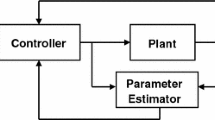Abstract
In this paper, the issue of actuator-structure interaction in dynamic testing of structures is considered. The problem is approached from the novel standpoint of impedance control. It is shown that an effective strategy to design controls for dynamic testing is by designing the test system impedance. It is also shown that this can be achieved using feedforward compensation. The analysis is carried out in the context of displacement controlled dynamic testing, when the tested structure has a high and nonlinear stiffness. It is demonstrated that stable and accurate dynamic testing can be achieved using the proposed strategy, when this is not possible using traditional feedback control techniques. Furthermore, the impedance control and feedforward strategies are applied in the context of hybrid simulation, a technique of coupling computational and physical substructures applied in earthquake engineering. Here, a delay compensation scheme is necessary in addition to feedforward. Experimental results are presented that demonstrate both improved dynamic testing performance when impedance control is employed, and its applicability in hybrid simulation.
Similar content being viewed by others
References
Bonnet PA, Williams MS and Blakeborough A (2007), “Compensation of Actuator Dynamics in Real-time Hybrid Tests,” Proceedings of the Institution of Mechanical Engineers. Part I: Journal of Systems and Control Engineering, 221(2): 251–264.
Combescure D and Pegon P (1997). “α-operator Splitting Time Integration Technique for Pseudodynamic Testing, Error Propagation Analysis,” Soil Dynamics and Earthquake Engineering, 16(7–8): 427.
Conte JP and Trombetti TL (2000), “Linear Dynamic Modeling of a Uni-axial Servo-hydraulic Shaking Table System,” Earthquake Engineering & Structural Dynamics, 29(9): 1375–1404.
Dimig J, Shield C, French C, Bailey F and Clark A (1999), “Effective Force Testing: A Method of Seismic Simulation for Structural Testing,” ASCE Journal of Structural Engineering, 125(9): 1028–1037.
Dyke SJ, Spencer BF, Jr, Quast P and Sain MK (1995), “Role of Control-structure Interaction in Protective System Design,” ASCE Journal of Engineering Mechanics, 121(2): 322–338.
Elkhoraibi T and Mosalam KM (2006), “Pseudodynamic Experiment on One-story RC Structure with and without Masonry Infill,” 8th U.S. National Conference on Earthquake Engineering, San Francisco, California.
Franklin GF, Powell JD and Emami-Naeini A (2002), Feedback control of dynamic systems, Prentice Hall PTR, Upper Saddle River, N.J. London.
Hilber HM, Hughes TJR and Taylor RL (1977), “Improved Numerical Dissipation for Time Integration Algorithms in Structural Dynamics,” Earthquake Engineering and Structural Dynamics, 5(3): 283–292.
Hogan N (1985), “Impedance Control: an Approach to Manipulation. I. Theory,” Transactions of the ASME. Journal of Dynamic Systems, Measurement and Control, 107(1): 1–7.
Horiuchi T, Inoue M, Konno T and Namita Y (1999), “Real-time Hybrid Experimental System with Actuator Delay Compensation and Its Application to a Piping System with Energy Absorber,” Earthquake Engineering and Structural Dynamics, 28(10): 1121–1141.
Jelali M and Kroll A (2003), Hydraulic Servo-systems: Modelling, Identification, and Control, New York: Springer.
Lang GF and Snyder D (2001), “Understanding the Physics of Electrodynamic Shaker Performance,” Sound and Vibration, 35(10): 24–33.
Lord Corporation (2006), “RD-1097-01 Friction Damper”.
Merritt HE (1967), Hydraulic Control Systems, New York: Wiley.
MTS Corporation (2003), “793.xx Software System”.
Nachtigal CL (1990), Instrumentation and Control: Fundamentals and Applications, New York: Wiley.
Nakashima M and Masaoka N (1999), “Real-time Online Test for MDOF Systems,” Earthquake Engineering & Structural Dynamics, 28(4): 393–420.
Pan P, Nakashima M and Tomofuji H (2005), “Online Test Using Displacement-force Mixed Control,” Earthquake Engineering & Structural Dynamics, 34(8): 869–888.
Reinhorn AM, Sivaselvan MV, Weinreber S and Shao X (2004), “Real-time Dynamic Hybrid Testing of Structural Systems,” 13th World Conference on Earthquake Engineering, Vancouver, B.C., Canada.
Shield CK, French CW and Timm J (2001), “Development and Implementation of the Effective Force Testing Method for Seismic Simulation of Large-scale Structures,” Philosophical Transactions of the Royal Society London-A, 359(1786): 1911–1929.
Shing PSB and Mahin SA (1984), “Pseudodynamic Test Method for Seismic Performance Evaluation: Theory and Implementation,” UCB/EERC-84/01, Earthquake Engineering Research Center.
Shing PSB and Mahin SA (1987), “Elimination of Spurious Higher-mode Response in Pseudodynamic Tests,” Earthquake Engineering & Structural Dynamics, 15(4): 425–445.
Shing PSB and Vannan MT (1991), “Implicit Time Integration for Pseudodynamic Tests, Convergence and Energy Dissipation,” Earthquake Engineering & Structural Dynamics, 20(9): 809.
Sivaselvan MV, Reinhorn AM, Shao X and Weinreber S (2008), “Dynamic Force Control with Hydraulic Actuators Using Added Compliance and Displacement Compensation,” Earthquake Engineering & Structural Dynamics, (Early View).
Tzierakis KG and Koumboulis FN (2003), “Independent Force and Position Control for Cooperating Manipulators,” Journal of the Franklin Institute, 340(6–7): 435–460.
Williams NS and Zakian V (1977), “A Ring of Delay Operators with Applications to Delay-differential Systems,” SIAM Journal on Control and Optimization, 15(2): 247–255.
Zhao J, French C, Shield C and Posbergh T (2003), “Considerations for the Development of Real-time Dynamic Testing Using Servo-hydraulic Actuation,” Earthquake Engineering & Structural Dynamics, 32(11): 1773–1794.
Zhao J, Shield C, French C and Posbergh T (2005), “Nonlinear System Modeling and Velocity Feedback Compensation for Effective Force Testing,” Journal of Engineering Mechanics, 131(3): 244–253.
Author information
Authors and Affiliations
Corresponding author
Additional information
Supported by: Dept. of Civil, Structural and Architectural Engineering and the College of Engineering and Applied Sciences of the University of Colorado at Boulder, USA
Rights and permissions
About this article
Cite this article
Carl, J., Sivaselvan, M.V. Improved dynamic testing by impedance control. Earthq. Eng. Eng. Vib. 10, 423–435 (2011). https://doi.org/10.1007/s11803-011-0078-9
Received:
Accepted:
Published:
Issue Date:
DOI: https://doi.org/10.1007/s11803-011-0078-9




